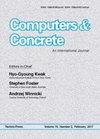Prediction of compressive strength of concrete modified with fly ash: Applications of neuro-swarm and neuro-imperialism models
IF 2.9
4区 工程技术
Q2 COMPUTER SCIENCE, INTERDISCIPLINARY APPLICATIONS
引用次数: 20
Abstract
In this study, two powerful techniques, namely particle swarm optimization (PSO) and imperialist competitive algorithm (ICA) were selected and combined with a pre-developed ANN model aiming at improving its performance prediction of the compressive strength of concrete modified with fly ash. To achieve this study's aims, a comprehensive database with 379 data samples was collected from the available literature. The output of the database is the compressive strength (CS) of concrete samples, which are influenced by 9 parameters as model inputs, namely those related to mix composition. The modeling steps related to ICA-ANN (or neuro-imperialism) and PSO-ANN (or neuro-swarm) were conducted through the use of several parametric studies to design the most influential parameters on these hybrid models. A comparison of the CS values predicted by hybrid intelligence techniques with the experimental CS values confirmed that the neuro-swarm model could provide a higher degree of accuracy than another proposed hybrid model (i.e., neuro-imperialism). The train and test correlation coefficient values of (0.9042 and 0.9137) and (0.8383 and 0.8777) for neuro-swarm and neuro-imperialism models, respectively revealed that although both techniques are capable enough in prediction tasks, the developed neuro-swarm model can be considered as a better alternative technique in mapping the concrete strength behavior.粉煤灰改性混凝土抗压强度预测:神经群模型和神经帝国模型的应用
本研究选择粒子群优化(PSO)和帝国主义竞争算法(ICA)两种强大的技术,并将其与预先开发的人工神经网络模型相结合,旨在改进其对粉煤灰改性混凝土抗压强度的性能预测。为了达到本研究的目的,从现有文献中收集了一个包含379个数据样本的综合数据库。数据库的输出是混凝土样品的抗压强度(CS), CS受9个参数作为模型输入的影响,即与配合比相关的参数。与ICA-ANN(或神经帝国主义)和PSO-ANN(或神经群)相关的建模步骤通过使用几个参数研究来设计这些混合模型上最具影响力的参数来进行。混合智能技术预测的CS值与实验CS值的比较证实,神经群模型可以提供比另一种提出的混合模型(即神经帝国主义)更高程度的准确性。神经群模型和神经帝国模型的训练相关系数分别为(0.9042和0.9137)和(0.8383和0.8777),结果表明,尽管这两种技术在预测任务中都有足够的能力,但所开发的神经群模型可以被认为是映射混凝土强度行为的更好的替代技术。
本文章由计算机程序翻译,如有差异,请以英文原文为准。
求助全文
约1分钟内获得全文
求助全文
来源期刊

Computers and Concrete
工程技术-材料科学:表征与测试
CiteScore
8.60
自引率
7.30%
发文量
0
审稿时长
13.5 months
期刊介绍:
Computers and Concrete is An International Journal that focuses on the computer applications in be considered suitable for publication in the journal.
The journal covers the topics related to computational mechanics of concrete and modeling of concrete structures including
plasticity
fracture mechanics
creep
thermo-mechanics
dynamic effects
reliability and safety concepts
automated design procedures
stochastic mechanics
performance under extreme conditions.
 求助内容:
求助内容: 应助结果提醒方式:
应助结果提醒方式:


